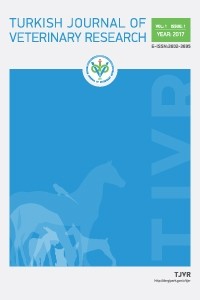The Microbiological Quality of Tantuni
The Microbiological Quality of Tantuni
Tantuni microbiological, Quality,
___
- 1. Ağaoğlu S, Alişarlı M, Alemdar S. Microbiologyc qualıty of the hamburger and chickenburger. YYU Vet Fak Derg 2000; 11(1): 40-43.
- 2. Ağaoğlu S, Güdücüoğlu H. Identification of E. coli O157:H7, Salmonella, Shigella and Campylobacter isolated from retail chicken products sold unpacked in Van. Bull Pure Apple Science 1999; 18(1): 25-30.
- 3. Akdağ HN. Determination of fast food consumption and habits among high school students Master’s Thesis, İstanbul: Okan Univ., Health Sciences Institute, 2015.
- 4. Alemdar S, Ağaoğlu S. Investigations on environmental and personnel hygiene in meat sales in Van. YYU Vet Fak Derg. 2000; 6(1-2): 53-60.
- 5. Anar Ş, Temelli S. Microbiologic quality of Iskender Kebap. Uludağ Univ Vet Fak Derg 2000; 19: 13-18.
- 6. Baydur AY. Investigation on hygienic quality of chicken meat on sale in Istanbul. Master’s Thesis, İstanbul: İstanbul Univ, Health Sciences Institute, 2006.
- 7. Baysal A, Küçükaslan N. Beslenme İlkeleri ve Menü Planlaması. Yenilenmiş 3. Ed., Bursa: Ekin Yayınevi, 279-283, 2009.
- 8. Cebirbay MA. Investigation of changes in microbiological quality during the sales period of Doner. Master’s Thesis, Konya: Selçuk Univ, Health Sciences Institute, 2007.
- 9. Coşkun F. Microbiological properties of spices sold in Tekirdag market. Tekirdağ Üniv. Ziraat Fak Derg 2010; 7(1): 85.
- 10. Cömert M. Fast food consumption habits of young people. Akademik Sosyal Araştırmalar Dergisi 2014; 6: 423-427.
- 11. Demirci M. Beslenme. 7. Baskı. İstanbul: Gıda Teknolojisi Derneği, Yayın No:44, 2014.
- 12. Efe M, Gümüşsoy KS. Microbiological analysis of chicken meat in Ankara garrison. Ankara Üniv. Health Sciences Institute 2005; 14(3): 151-157.
- 13. Gençer VK, Kaya M. Microbiological Quality and Chemical Composition of the Döner. Turkish Journal of Veterinary and Animal Science 2004; 28: 1097-1103.
- 14. Göktan D, Tunçel G. Gıda İşletmelerinde Hijyen. Gıda Hijyeni 2. İzmir: Meta Basım, 2010.
- 15. Halkman AK. Gıda Mikrobiyolojisi Uygulamaları. 1. Baskı, Ankara: Başak Matbaacılık Ltd Şti, 2005.
- 16. Kayışoğlu S, Yılmaz İ, Demirci M, Yetim H. Chemical composition and microbial quality of döner kebabs sold in Tekirdag market. Food Control 2003; 14: 469-474.
- 17. Koçak N. Yiyecek İçecek İşletmelerinde Gıda ve Personel Hijyeni. Ankara: Detay Yayıncılık, 2007.
- 18. Küpeli V. Chemical composition and microbial quality of döner. Master’s Thesis, Erzurum: Atatürk Univ., Science Institute, 1996.
- 19. Merdol TK. Toplu Beslenme Servisi (TBS) Sağlıklı Yönetim Rehberi. 1. Baskı, Bölüm 2, Ankara: Hatiboğlu Yayınevi, 41-69, 2015.
- 20. Öztürk U. Microbiologic quality of minced meat and red meat sold in Antalya. PhD Thesis, Konya: Selçuk Univ, Health Sciences Institute, 2007.
- 21. Sümbüllüoğlu K, Sümbüllüoğlu V. Biostatistics. 16. Baskı, Ankara: Hatipoğlu Pres, 1-229, 2014.
- 22. Tayar M, Korkmaz NH, Özkeleş HE. Beslenme İlkeleri. 3. Baskı, Bursa: Dora Basım, 2015.
- 23. Topçu S. A study on the isolation of Listeria monocytogenes, Staphylococcus aureus, Aeromonas hydrophila and the determination of resistance to various antibiotics from doner kebab varieties sold in Ankara. Master’s Thesis, Ankara, Gazi Univer, Science Institute, 2006.
- 24. Toprak Y. Implementation of the HACCP system in the school of land warfare. Master’s Thesis, Ankara: Ankara Univ, Health Sciences Institute, 2000.
- Başlangıç: 2017
- Yayıncı: Ebubekir CEYLAN
Prevalence of Gastrointestinal Helminths in Stray Dogs in Van Province
Muhammad Zeeshan AKRAM, Muhamad SALMAN, Hassan JALAL, Umair ASGHAR, Zeshan ALİ, Muhammad Hassan JAVED, Minahil KHAN
Evan Abdulkarim MAHMOOD, Tahir KAHRAMAN
Abolfazl JAFARİ-SALES, Azizeh SHADİ-DİZAJİ
Comparison of Some Bacterial Identification Methods
Özgül GÜLAYDIN, İsmail Hakkı EKİN, Cihat ÖZTÜRK, Ziya İLHAN, Erdal ÖĞÜN
Alternative treatment studies for leishmaniasisis
Özlem Makbule KAYA, Şerife AKKÜÇÜK, Mehmet YAMAN
